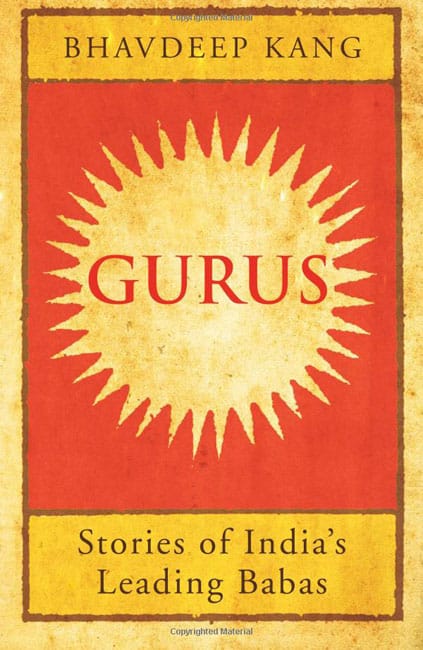SUBJECT: 4/5
RELEVANCE: 3.5/5
WRITING STYLE: 2/5
ENTERTAINMENT QUOTIENT: 2/5
“Why nine gurus? Well, the Bhagavad Gita has nine times two chapters. The Goddess Durga has nine forms (hence Navaratri). The human body has nine doors. The Natyashastra describes nine emotions. There are nine planets, nine primary gems, nine kinds of grains and so on. Dante describes nine circles of hell; Norse mythology speaks of nine worlds.”
~ Bhavdeep Kang, Gurus: Stories of India’s Leading Babas
My Musings
Having attended Sadhuguru’s speaker session at a recent event in Hubbali, I was looking to read a book about spiritual leaders or gurus of India.
My search yielded results when I came across this interesting looking book in the Kindle Unlimited section.
Since the book had already piqued my interest, I did not waste much time and quickly downloaded it.
Read on to know what I think about Bhavdeep Kang’s Gurus: The Story of India’s Leading Babas, a book that failed to deliver what it promised.
What to expect?
In Gurus: The Story of India’s Leading Babas, expect a book that talks about India’s leading gurus in a rather unimpressive manner.
In fact, unimpressive is a much humble word because the book, in the treatment of most of the babas, is as condescending as it gets.
So, if you are thinking about picking this one up for reading something about the various spiritual gurus and their works, there is just one word that I would tell you – don’t.
On the other hand, if you are a sceptic and love being snobbish about everything that doesn’t fit your pattern – congratulations! You have got yourself a wonderful companion in your mystic bashing journey.
What is the book all about?
The book aims to tell us the story of India’s leading babas from a neutral perspective (where it fails miserably but more about that later). The author has compiled the stories of 9 babas who are popular and rather well known in modern-day India.
As per the author there are two criterions that helped her narrow down the from an overwhelming list of possible names that could have made their way into the book – (1) they are all “entrepreneurs, self-made gurus who do not belong to any pre-existing organizations” (2) they all “broadly fall within the Hindu tradition”.
Let’s talk about the writing style
The that the author selects for her writing venture have chapters named after them in a rather debasing manner. As can be understood, this paves the way for the demeaning tone in which the author decides to write the rest of the book.
For example, some of the chapters are titled The Pop Guru: Maharishi Mahesh Yogi, Indira Gandhi’s Guru: Dhirendra Brahmachari, The Shaman-Shyster: Chandraswami, The Art of Selling Love: Ravi Shankar and The Metrosexual Seer: Bhaiyyuji Maharaj.
It would be quite exhausting if I start quoting the disgusting attempts at sarcasm that the book is so full of. The only question that I had in mind was this – why pick up a topic (and subjects) that you so passionately dislike (or even hate)? Why not write about something that you really like?
The author seems to be good at words; her language is rich but the only use that such a vast vocabulary was put to was in belittling her subjects.
What I did not like?
The book, as you would have already understood, is an attempt to malign, shame and condemn. Instead of focusing on the spiritual aspects and achievements, the author portrays the gurus as charlatans, pleasure seekers, money mongers, power brokers etc.
About Mata Amritaanandmayi she writes, “Amma’s homespun ecological wisdom is derived from the same source as her famous hug and dramatic lapse into Krishna or Devi mode or “bhava”; a shrewd understanding of what is likely to appeal to her auditors.”
In the chapter about Sri Sri Ravi Shankar she writes, “AoL is for the beautiful people, for westerners and the materially endowed. For people of leisure, whose bodily comfort amplifies disquietude. For those who seek legitimacy in being part of something bigger than themselves. The faith that abides through suffering, the kind that moves mountains, that’s for the hundreds of thousands who show up at Shirdi or Harmandir Sahib or Ajmer Sharif, their relentless devotion powered not by a smile, but an intimate kinship with the deity.”
Sadhguru Jaggi Vasudev gets the best judgement, about him she writes “Jaggi is a consummate showman: charismatic, provocative, surprising.”
The only respite from her endless venom spitting is the chapter on Morari Bapu who is luckily the only mystic she has spared from her prejudiced conclusions.
Is the book entertaining?
By the time I was into the second chapter, I had realized that Gurus: The Story of India’s Leading Babas is more like a collection of biased personal opinions and rants rather than a fair evaluation of the subjects that it talks about.
Nevertheless, I am not a quitter and the only reason that I continued reading was that there were many that I had known nothing about. I wanted to see if there was even a single baba whom the author was not disgusted by and thankfully there was. Morari Bapu is the only mystic whom she does judge harshly.
In the end, entertaining is a word that I would rather not use for this book. My preferred word would be – revolting.
Pick up the book
Only if you are a baba hater or hater of anything remotely concerned with babas, mystics, spiritual gurus, Hindu religious leaders.
Skip the book
- If you are looking for an unbiased read.
- If you are looking for an authentic read as opposed to a judgmental and condescending book on the topic.
Can’t wait to read it? Buy your copy of Gurus: The Story of India’s Leading Babas using the link below.
